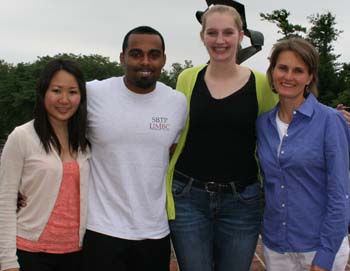
Parker de Waal ’13 had a wish: he wanted to work on a computational chemistry project.
Laura Furge, the Roger F. and Harriet G. Varney Professor of Chemistry, had a challenge: she needed models of the variants of an important human enzyme. (Some background: The aforementioned enzyme, found in the liver, helps the body process medicines, but it’s not exactly the same–hence, variants–in all individuals. Such variability means some people react differently (including adversely) to important medicines. That’s a serious health problem, and part of Furge’s current grant from the National Institutes of Health calls for the study of these variants. And for such study a model of the variants’ structures would certainly be useful!)
In spring 2013, wish met challenge, and, one year later, the two researchers (along with co-author Kyle Sunden ’16) have published a paper in PLoS ONE, the online journal of the Public Library of Science.
That culminating publication traces back to a laboratory question: Could de Waal (a student in Furge’s “Advanced Biochemistry” class) make computational models of the variants? “I suggested some different ways to approach the problem,” says Furge, “and those approaches took Parker all of about two days!” It was at that point that de Waal suggested to Furge some different, more powerful computational approaches–specifically, molecular dynamics using more sophisticated software. “I said, ’Let’s go for it!’” says Furge. “And we both started on the journey to learn more about Molecular Dynamics approaches.”
The journey included consulting with other scientists around the country and the world (Germany, the Czech Republic) both by email and in person at various scientific conferences. Furge and de Waal used a supercomputer at the University of Texas for the computational work. Analysis of the resulting structures was completed by Furge and Sunden during the winter and spring terms of 2014. “The project is a beautiful example of how research and teaching go together at K,” says Furge. The work has been presented at two major medical meetings.
The paper includes 21 figures and tables. Parker de Waal performed all the experiments that led to the figures; Sunden did the experiments and analyses for two of the figures. Furge did the majority of the analysis. In true liberal arts fashion, the cross-disciplinary work combines computer science and biochemistry. Furge taught Sunden, a chemistry and computer science double major, the relevant biochemistry as they progressed with the project. Sunden hopes to continue the work for his Senior Individualized Project after he returns from study abroad in Australia. The work may one day contribute to personalized solutions for people who have adverse drug reactions to important medicines. The paper has had more than 300 views in the six weeks since it’s been published.
Great academics, cross-disciplinary collaboration, research at the edge, and science that matters! Science education at Kalamazoo College: a double helix of challenge and imagination.










